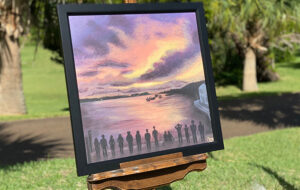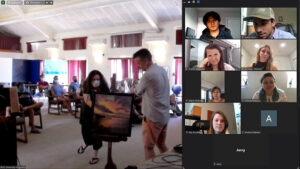A Picture is Worth a Thousand Words

An intern with the National Science Foundation Research Experiences for Undergraduates (REU) program was so impacted by his time at BIOS that he sought out an artist to replicate a photograph depicting one of his most treasured moments. Harvey Castillo, a 2019 REU intern at BIOS, gave prints of the painting by artist Claudia Palacios to his REU cohort and members of the 2019 BIOS fall semester, all of whom shared time with him at the Institute. As a surprise, Castillo then sent a copy to BIOS Education Department.
A new painting graces the walls of the BIOS reception building commemorating friendships formed during the Institute’s 2019 National Science Foundation Research Experiences for Undergraduates (REU) internship and fall semester program. Commissioned by REU intern Harvey Castillo, then a biology major at Northern Arizona University (U.S.), and painted by visual artist Claudia Palacios, the piece reproduces a photograph of Castillo and fellow students watching a sunset from the dock at the BIOS waterfront.
Recalling his three months at BIOS, Castillo said it “quickly became a very special time in my life; it was a time that I finally discovered what I wanted to do with my life. I felt like I finally became the person that I wanted to be.”
During his REU internship, he worked with comparative physiologist and biological oceanographer Amy Maas on a project investigating how temperature impacts the oxygen consumption and ammonium excretion of small zooplankton called copepods. His research looked at whether these two metabolic processes responded to an increase in temperature, as well as how they change at different times of the day as part of the animals’ natural circadian rhythms.
However, it was time spent out of the lab that most impacted Castillo.

n late August, with Castillo and some of his REU cohort on Zoom, and joined by the 2021 BIOS REU interns in the live audience, a framed piece of Palacio’s artwork was unveiled to be hung in the BIOS reception building. “I want all those who come to BIOS to know that it is a place where they belong, where they can feel like home, and to feel all of the same love and happiness that I felt when I was there,” he said.
Nearly every evening, Castillo and his fellow students could be found at the dock or Whalebone Bay hanging out, talking, and watching the sunset together. “Those became some of my favorite memories,” he said. “I learned a lot through those small experiences. During those little moments I learned to take a step back and appreciate the world around me and enjoy being in the here and now.”
Upon returning to the U.S., Castillo wanted to commemorate his time at BIOS, for himself, fellow students, and future visitors to the Institute. He turned to memories of those sunsets for inspiration. Castillo said that someone once told him that “there is a sunset every day of a person’s life, but how many of those are actually noticed?”
The painting, unveiled during a Zoom call in late August, captures this special moment. Castillo surprised the students depicted in the photograph with a copy of the painting for Christmas, and also gifted BIOS with a copy to hang on its walls.
“I want people who pass through BIOS to see the painting and feel inspired,” Castillo said. “BIOS is a place that offers incredible experiences and it can open so many doors in life, and I want people to feel like they can accomplish any goal they set for themselves the same way that I did. Most importantly I want all those who come to BIOS to know that it is a place where they belong, where they can feel like home, and to feel all of the same love and happiness that I felt when I was there.”
Castillo, now 24, lives in Los Angeles, California. Since graduating from Northern Arizona University in 2020, he decided to spend time exploring various science jobs and gaining experience working in the field. He recently returned from working as a camp counselor and educator at a summer camp in South Carolina where he taught students aged eight to 13 about marine science and the natural world. He is also active as a volunteer at The Aquarium of the Pacific in Long Beach, California. Through these experiences, Castillo discovered that he loves connecting people to science, wildlife, and the environment.
He also plans to attend graduate school in the near future and hopes to find a program that combines his interests in urban sustainability and carbon sequestration.
“One of my big goals is to help my hometown of Los Angeles set the bar among large metropolitan landscapes in sustainability and carbon emissions,” Castillo said. “I’m aiming to find novel ways to build green spaces and implement healthy soil programs around the city, particularly in low-income and minority neighborhoods that often lack these features.”
